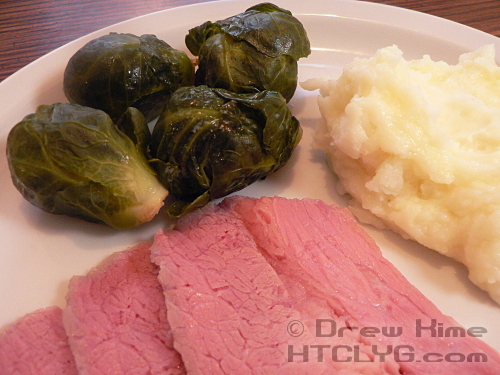As I was buying my corned beef brisket for St. Patrick’s Day this year, it occurred to me that it was, after all, a brisket. And usually I would braise a brisket. Why does corned beef have to be boiled? Turns out, it probably doesn’t.
As a first attempt this was surprisingly good. It suggests braising may give you a much more flavorful meat. But it doesn’t seem to cut any time off the normal preparation, which is what I was really hoping for.
For anyone who wants to follow-up my experiment before I make it again, here’s the first attempt, with some pointers and ideas for the next try.
Directions
Next year I’ll try processing a fresh brisket. For this year’s experiment I just bought one ready-to-cook. Most grocery stores only have these for a few weeks around St. Patrick’s Day. My butcher has them year-round.
Braising is cooking the meat mostly submerged in liquid. The easiest way to do this with the minimum liquid — which keeps the flavor concentrated — is to wrap the meat somewhat tightly in foil. This is the same process I used for my pork spareribs.
I checked the width, and the regular foil wasn’t wide enough to wrap all the way around the brisket.
So I had to make some extra-wide myself. Tear off two pieces, each about 6 inches longer than the long measurement of the brisket. Lay one on top of the other with the edges meeting up.
Fold the edges over several times, pinching tightly.
Fold the top piece back, and press the seam flat.
Now that you’ve got a big enough piece of foil, lay the brisket in it and fold all the edges up. Keep the corners neat, like hospital corners on a bed, or like you’re wrapping a Christmas gift.
The neat corners will help keep all the liquid inside.
Remove the brisket and lower the foil into the smallest roasting pan you have that will fit the whole brisket.
Finally you can cut open the brisket. Dump the meat into the foil and remove the seasoning packet.
Add enough water come just to the top edge of the brisket. (Since I needed water anyway, I rinsed the package out to get the last of the flavor out of it.)
Open the seasoning packet and distribute the contents through the water on each side.
Fold the edges of the foil together and pack it closely down around the beef.
I cooked this for three hours at 200°. Because I had been careful with the corners none of the liquid spilled out.
With the ribs, I lifted the packet out, opened one end, and poured the liquid into a pot. I tried that here.
Remember when I said I didn’t have any wide foil, so I made my own by folding the edges of two pieces together? Yeah, well I forgot that. I made it out of the roasting pan and almost down onto the cutting board before the seam let go.
Someone suggested recently that the reason we buy smooth-top stoves is for the extra counter space. Maybe that’s not the main reason, but boy am I ever glad I didn’t do this over a gas stovetop. I’d still be cleaning it today.
Boiled corned beef and cabbage has never been the prettiest dish back in the kitchen. But this was … umm … not presentable the way it came out of the stove.
Everywhere the foil was touching the top it remained pink, everywhere it didn’t touch turned greyish. Or vice-versa, I couldn’t really tell which. Either way, you wouldn’t want people seeing this until it’s been sliced.
Slice thinly across the grain as much as you think everyone will eat at the first meal.
This stayed the bright pink color it was before I started cooking. The color, and in fact the texture, was a lot like ham. Except that the fatty bits of this were chewy and inedible.
Since I was braising this, there wouldn’t be a pot of water to boil the cabbage in. That’s why I went with the brussels sprouts. Boiled cabbage taste, without having to boil the beef.
When I try this again, I’ll go for as much cooking time as I can get. I took the un-sliced portion of this and boiled it for two more hours. The texture was perfect. So braising seems like it could be a good option for corned beef. I just need to cook it for the same 6 hours I’d normally boil it.
I’ll let you know when I try it again. If you beat me to it, or if you’ve done this before, let me know down in the comments.






























